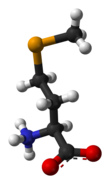| |||
| Names | |||
|---|---|---|---|
| IUPAC name
2-Amino-4-(methylselanyl)butanoic acid
| |||
| Other names
MSE
| |||
| Identifiers | |||
3D model (JSmol)
|
|||
| ChEBI | |||
| ChemSpider | |||
| ECHA InfoCard | 100.014.525 | ||
PubChem CID
|
|||
| UNII |
| ||
CompTox Dashboard (EPA)
|
|||
| |||
| |||
| Properties | |||
| C5H11NO2Se | |||
| Molar mass | 196.106 g/mol | ||
Except where otherwise noted, data are given for materials in their standard state (at 25 °C [77 °F], 100 kPa).
| |||
Selenomethionine (SeMet) is a naturally occurring amino acid. The L-selenomethionine enantiomer is the main form of selenium found in Brazil nuts, cereal grains, soybeans, and grassland legumes, while Se-methylselenocysteine, or its γ-glutamyl derivative, is the major form of selenium found in Astragalus, Allium, and Brassica species.[1] In vivo, selenomethionine is randomly incorporated instead of methionine. Selenomethionine is readily oxidized.[2]
Selenomethionine's antioxidant activity arises from its ability to deplete reactive oxygen species. Selenium and methionine also play separate roles in the formation and recycling of glutathione, a key endogenous antioxidant in many organisms, including humans.
- ^ Whanger, P. D. (2002). "Selenocompounds in plants and animals and their biological significance". Journal of the American College of Nutrition. 21 (3): 223–32. doi:10.1080/07315724.2002.10719214. PMID 12074249. S2CID 20483595.
- ^ Block, E.; Birringer, M.; Jiang, W.; Nakahodo, T.; Thompson, H. J.; Toscano, P. J.; Uzar, H.; Zhang, X.; Zhu, Z. (2001). "Allium chemistry: synthesis, natural occurrence, biological activity, and chemistry of Se-alk(en)ylselenocysteines and their γ-glutamyl derivatives and oxidation products". Journal of Agricultural and Food Chemistry. 49 (1): 458–70. doi:10.1021/jf001097b. PMID 11305255.

